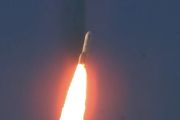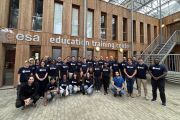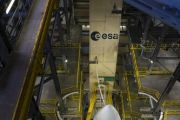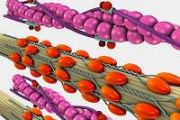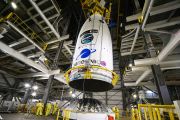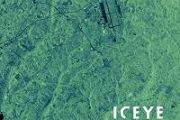
Copernical Team
Collision of equal sized bodies may explain Mercurys unique composition
 A new study suggests that Mercury's unusual structure may have resulted from a grazing collision between two similar sized protoplanets, rather than a rare catastrophic impact with a much larger body. Mercury's dense metallic core makes up about 70% of its mass, while its rocky mantle remains unusually thin compared to other terrestrial planets.
The research, led by Patrick Franco of the N
A new study suggests that Mercury's unusual structure may have resulted from a grazing collision between two similar sized protoplanets, rather than a rare catastrophic impact with a much larger body. Mercury's dense metallic core makes up about 70% of its mass, while its rocky mantle remains unusually thin compared to other terrestrial planets.
The research, led by Patrick Franco of the N Earth from Space: Northeast Greenland National Park
 Image:
Part of the icy landscape of the Northeast Greenland National Park, the largest national park in the world, is pictured in this Copernicus Sentinel-2 image.
Image:
Part of the icy landscape of the Northeast Greenland National Park, the largest national park in the world, is pictured in this Copernicus Sentinel-2 image. ESA shares stage with international partners at IAC 2025

The European Space Agency (ESA) is participating in the 76th International Astronautical Congress (IAC), which will open its doors on Monday 29 September and last until Friday 3 October in Sydney, Australia. Over 8000 participants from 90 countries are expected to attend the event at the International Convention Centre (ICC) under the theme “Sustainable Space: Resilient Earth”.
Exoplanets unlikely to host global oceans
 Astronomers once suggested that the exoplanet K2-18b, 124 light-years away, could be an ocean world filled with life. A new study led by ETH Zurich shows that such sub-Neptune planets are far drier than previously assumed, making them poor candidates for habitable conditions.
"Water on planets is much more limited than previously believed," said ETH Zurich professor Caroline Dorn. The stud
Astronomers once suggested that the exoplanet K2-18b, 124 light-years away, could be an ocean world filled with life. A new study led by ETH Zurich shows that such sub-Neptune planets are far drier than previously assumed, making them poor candidates for habitable conditions.
"Water on planets is much more limited than previously believed," said ETH Zurich professor Caroline Dorn. The stud Record breaking gravitational waves confirm Hawking theory and reveal giant black hole merger
 For millions of years, two massive black holes circled each other until, in a split second, they merged at near light speed. The collision unleashed gravitational waves so strong and clear that researchers now have their most detailed look yet at spacetime's most violent events.
"These are waves in spacetime itself-like ripples in water-that travel at the speed of light," explained Jose Ma
For millions of years, two massive black holes circled each other until, in a split second, they merged at near light speed. The collision unleashed gravitational waves so strong and clear that researchers now have their most detailed look yet at spacetime's most violent events.
"These are waves in spacetime itself-like ripples in water-that travel at the speed of light," explained Jose Ma White dwarf consumes icy Pluto-like planet fragment in deep space
 University of Warwick astronomers have identified the chemical signature of an icy, water-rich planetary fragment being devoured by a white dwarf star. The finding offers strong evidence that volatile-rich planetesimals, capable of delivering water and the raw ingredients for life, exist in systems beyond our Solar System.
The team used ultraviolet spectroscopy from the Hubble Space Telesc
University of Warwick astronomers have identified the chemical signature of an icy, water-rich planetary fragment being devoured by a white dwarf star. The finding offers strong evidence that volatile-rich planetesimals, capable of delivering water and the raw ingredients for life, exist in systems beyond our Solar System.
The team used ultraviolet spectroscopy from the Hubble Space Telesc Mars polar vortex traps cold and builds seasonal ozone layer
 A rare look inside the wintry north polar vortex of Mars has revealed that conditions are far colder than outside its boundary, and that the months of complete darkness allow ozone to accumulate in the martian atmosphere.
"The atmosphere inside the polar vortex, from near the surface to about 30 kilometres high, is characterised by extreme cold temperatures, about 40 degrees Celsius colder
A rare look inside the wintry north polar vortex of Mars has revealed that conditions are far colder than outside its boundary, and that the months of complete darkness allow ozone to accumulate in the martian atmosphere.
"The atmosphere inside the polar vortex, from near the surface to about 30 kilometres high, is characterised by extreme cold temperatures, about 40 degrees Celsius colder Cosmic glass in Australia reveals traces of massive asteroid strike
 Curtin University scientists have identified evidence of a giant asteroid impact hidden in tiny fragments of natural glass, known as tektites, found only in Australia.
Tektites form when a space rock collides with Earth, melts surface material, and blasts molten debris across vast distances. The newly recognised tektites, discovered mainly in South Australia, mark a previously unknown impa
Curtin University scientists have identified evidence of a giant asteroid impact hidden in tiny fragments of natural glass, known as tektites, found only in Australia.
Tektites form when a space rock collides with Earth, melts surface material, and blasts molten debris across vast distances. The newly recognised tektites, discovered mainly in South Australia, mark a previously unknown impa Northrop Grumman Hypersonic Navigation System Exceeds Rocket Test Milestones
 Northrop Grumman's Advanced Hypersonic Technology Inertial Measurement Unit (AHT IMU) has surpassed expectations in its third major test, this time onboard a sounding rocket. The trial confirmed the unit's ability to withstand extreme g-forces, altitudes, and velocities beyond projected limits.
The navigation system demonstrated reliable operation in GPS-denied environments, validating its
Northrop Grumman's Advanced Hypersonic Technology Inertial Measurement Unit (AHT IMU) has surpassed expectations in its third major test, this time onboard a sounding rocket. The trial confirmed the unit's ability to withstand extreme g-forces, altitudes, and velocities beyond projected limits.
The navigation system demonstrated reliable operation in GPS-denied environments, validating its Teledyne Labtech and Bangor University advance Welsh space cooling technology
 Teledyne Labtech is leading a Welsh effort to rethink thermal management for spacecraft electronics through the Advanced Thermal Management for Space Electronics project, developed with Bangor University and supported by Airbus Endeavr, a joint initiative between Airbus and the Welsh Government.
The collaboration targets one of space engineering's hardest problems: moving heat in vacuum. T
Teledyne Labtech is leading a Welsh effort to rethink thermal management for spacecraft electronics through the Advanced Thermal Management for Space Electronics project, developed with Bangor University and supported by Airbus Endeavr, a joint initiative between Airbus and the Welsh Government.
The collaboration targets one of space engineering's hardest problems: moving heat in vacuum. T 
